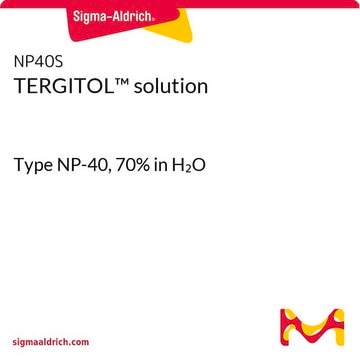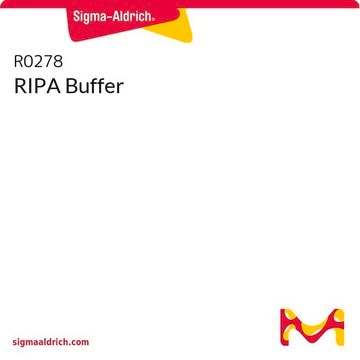If this product has an expiration or retest date, it will be shown on the Certificate of Analysis (COA, CofA). If there is no retest or expiration date listed on the product's COA, we do not have suitable stability data to determine a shelf life. For these products, the only date on the COA will be the release date; a retest, expiration, or use-by-date will not be displayed.
For all products, we recommend handling per defined conditions as printed in our product literature and website product descriptions. We recommend that products should be routinely inspected by customers to ensure they perform as expected.
For products without retest or expiration dates, our standard warranty of 1 year from the date of shipment is applicable.
For more information, please refer to the Product Dating Information document: https://www.sigmaaldrich.com/deepweb/assets/sigmaaldrich/marketing/global/documents/449/386/product-dating-information-mk.pdf
Kluczowe dokumenty
I8896
IGEPAL® CA-630
for molecular biology
Synonim(y):
Octylphenoxy poly(ethyleneoxy)ethanol, branched
Wybierz wielkość
Wybierz wielkość
About This Item
Polecane produkty
klasa czystości
for molecular biology
Poziom jakości
opis
non-ionic
Formularz
liquid
metody
IR spectroscopy: suitable
CMC
0.08 mM (20-25°C)
HLB
13
obecność zanieczyszczeń
DNase and RNase, none detected
ciąg SMILES
O(CCO)c1ccc(cc1)C(CC(C)(C)C)(C)C
InChI
1S/C16H26O2/c1-15(2,3)12-16(4,5)13-6-8-14(9-7-13)18-11-10-17/h6-9,17H,10-12H2,1-5H3
Klucz InChI
JYCQQPHGFMYQCF-UHFFFAOYSA-N
Szukasz podobnych produktów? Odwiedź Przewodnik dotyczący porównywania produktów
Opis ogólny
Zastosowanie
Inne uwagi
Jakość
Przestroga
Informacje prawne
Hasło ostrzegawcze
Danger
Zwroty wskazujące rodzaj zagrożenia
Zwroty wskazujące środki ostrożności
Klasyfikacja zagrożeń
Acute Tox. 4 Oral - Aquatic Acute 1 - Aquatic Chronic 1 - Eye Dam. 1 - Skin Irrit. 2
Kod klasy składowania
10 - Combustible liquids
Klasa zagrożenia wodnego (WGK)
WGK 2
Temperatura zapłonu (°F)
483.8 °F - closed cup
Temperatura zapłonu (°C)
251 °C - closed cup
Środki ochrony indywidualnej
Eyeshields, Gloves, type ABEK (EN14387) respirator filter
Wykazy regulacyjne
Wykazy regulacyjne dotyczą głównie produktów chemicznych. Można w nich podawać ograniczoną liczbę informacji na temat produktów niechemicznych. Brak wpisu oznacza, że żaden ze składników nie znajduje się w wykazie. Użytkownik odpowiada za zagwarantowanie bezpiecznego i zgodnego z prawem stosowania produktu.
EU REACH SVHC Candidate List
EU REACH Annex XIV (Authorisation List)
Wybierz jedną z najnowszych wersji:
Masz już ten produkt?
Dokumenty związane z niedawno zakupionymi produktami zostały zamieszczone w Bibliotece dokumentów.
Klienci oglądali również te produkty
Protokoły
Procedure and protocol for Anti Ago-RNA Immunoprecipitation from mammalian cells using the RIP kit
This page provides information about different pull-down assays for the further isolation of multiprotein complexes to identify their components with products from Cytiva.
Ta strona zawiera informacje o różnych testach pull-down do dalszej izolacji kompleksów wielobiałkowych w celu identyfikacji ich składników za pomocą produktów Cytiva.
Powiązane treści
Investigate in vitro protein-protein interactions with pull-down assays, utilizing affinity, GST pull-down, TAP, and co-immunoprecipitation methods.
Badanie interakcji białko-białko in vitro za pomocą testów pull-down, z wykorzystaniem metod powinowactwa, GST pull-down, TAP i koimmunoprecypitacji.
-
How can I determine the shelf life / expiration / retest date of this product?
1 answer-
Helpful?
-
-
How is shipping temperature determined? And how is it related to the product storage temperature?
1 answer-
Products may be shipped at a different temperature than the recommended long-term storage temperature. If the product quality is sensitive to short-term exposure to conditions other than the recommended long-term storage, it will be shipped on wet or dry-ice. If the product quality is NOT affected by short-term exposure to conditions other than the recommended long-term storage, it will be shipped at ambient temperature. As shipping routes are configured for minimum transit times, shipping at ambient temperature helps control shipping costs for our customers. For more information, please refer to the Storage and Transport Conditions document: https://www.sigmaaldrich.com/deepweb/assets/sigmaaldrich/marketing/global/documents/316/622/storage-transport-conditions-mk.pdf
Helpful?
-
-
In which solvent(s) is Atazanavir Sulfate soluble?
1 answer-
Atazanavir Sulfate is soluble in DMSO: 104mg/mL and EtOH: 20mg/mL.
Helpful?
-
-
What is the storage temperature for this item?
1 answer-
This product may be stored at room temperature. For products with no specified storage temperature given on the label or product page, ambient storage may be assumed. Products that require controlled temperature storage, such as refrigeration or freezer conditions, storage temperatures are published on the product label, Certificate of Analysis, the Safety Data Sheet (SDS).
Helpful?
-
-
Hi, I am enquiring about the storage temperature of product IGEPAL(R) CA-630 (I8896-100ml). The storage class is listed in the SDS but no temperature upper and lower limits. Would I be able to request this information. Thank you
1 answer-
This product may be stored at room temperature. For products with no specified storage temperature given on the label or product page, ambient storage may be assumed. Products that require controlled temperature storage, such as refrigeration or freezer conditions, storage temperatures are published on the product label, Certificate of Analysis, and the Safety Data Sheet (SDS).
Helpful?
-
-
What is the molecular weight of Product No. I8896, IGEPAL® CA-630?
1 answer-
The approximate molecular weight of this product is 603 Daltons. The average EO (ethylene oxide) units per molecule are 9.
Helpful?
-
-
What is the wt/vol % of this IGEPAL reagent? I want to use it for ATAC-seq and in the protocols people always mention the concentration of the stock is 10% wt/vol but I can't find this information on the specifications of this product. Thanks
1 answer-
This product is provided as a neat liquid with a concentration of 100% which can be further diluted. The density of IGEPAL CA-630 is 1.06 g/cm3 at 25 °C. For a 10% wt./vol. solution 9.43 mL IGEPAL is needed per 100 mL of solution.
The product is generally stable based on the chemical composition and a 10% (w/v) aqueous solution may be stable refrigerated for at least one month. However, it is important to minimize the exposure of the solution to oxygen (keep closed soon after use). The product does have a tendency to oxidize in air forming peroxides through a free radical process. In addition, some bacterial growth may occur which is evidenced by an odor or formation of a precipitate. Preservatives added to the solution may prevent bacterial growth. Please view the data sheet below: https://www.braskem.com.br/Portal/Principal/Arquivos/html/boletm_tecnico/PP%20Chemical%20Resistance.pdf
Helpful?
-
-
What is the CMC (critical micellar concentration) value of Product No. I8896, IGEPAL® CA-630?
1 answer-
The CMC value of this product is 0.083 mM.
Helpful?
-
-
What does "Molecular Biology Grade" mean?
1 answer-
Molecular Biology Grade means that this product must meet the DNase, RNase, and Nickase specification on the Certificate of Analysis for each lot of the product.
Helpful?
-
-
What is the formula weight of Product No. I8896, IGEPAL® CA-630?
1 answer-
The formula weight of this product is 603.
Helpful?
-
Active Filters
Nasz zespół naukowców ma doświadczenie we wszystkich obszarach badań, w tym w naukach przyrodniczych, materiałoznawstwie, syntezie chemicznej, chromatografii, analityce i wielu innych dziedzinach.
Skontaktuj się z zespołem ds. pomocy technicznej










